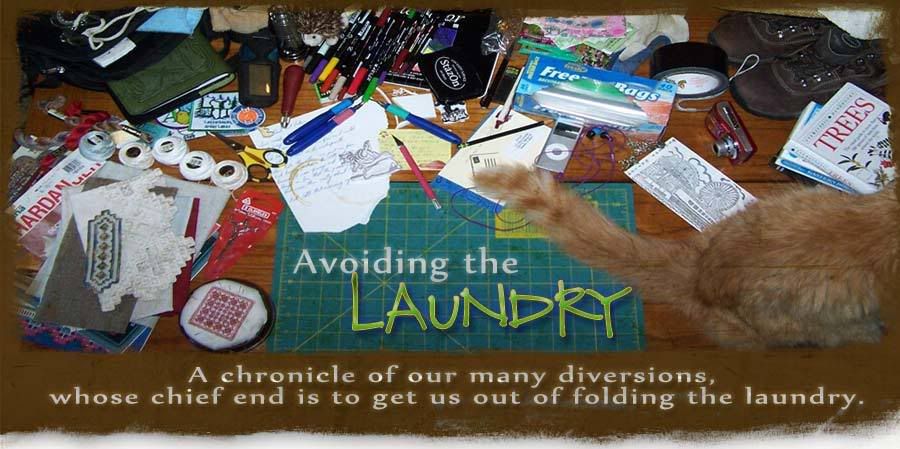Once upon a time~well, last October, if you must know~two farmers named Chad and Duane planted some grass seed. To be more precise, they planted three whole fields of hard red winter wheat. The seed started to grow, but then the cold winter winds began to blow and so the grass lay dormant under a blanket of snow for many months. While the green shoots slept, the sun shone a little brighter each day and melted the snow and warmed the soil, until finally one day, the wheat awoke and stretched itself toward the spring sky. The grass grew stronger and stronger. The gentle rains and hot sun gave it the energy to make a plump seed head of it's own. Then the drying summer winds came and the stalk turned crisp and golden and whispered with it's neighbors through the starlit nights.
The farmers returned one day after the wheat was stiff and dry and had long forgotten what it felt like to be grass. They cut the wheat with large, noisy machines that billowed clouds of dust behind them. The hollow stalks were cast aside for someone else and the seed heads rubbed against the drum inside the harvester until all of the little kernels fell away and were carried into a holding bin.

Eventually, all of the kernels were transferred to semi trucks and taken away. The wheat berries (also known as kernels) didn't know it, but they were in for the processing ride of their life. They would be sorted and cleaned and sorted again. Some of them would be ground into various forms of flour to be made into cereal and bread and the like. Others were destined to become beer and even stranger creations.

A relatively small amount of the kernels were set aside and taken to the farmers' wives. They would create a Julnek to celebrate the blessings God had given them in a bountiful harvest.
(It should be noted that "Bearded Wheat" is much prettier, but as you can imagine, all of those barbed pieces caused innumerable amounts of equipment grief, and thus farmers everywhere rejoiced when the beards were engineered right off the plants. In an extreme effort at self restraint, I am going to avoid the rant about how
all grain is genetically engineered now days, and the protestors against such are
insane.)

They would also mill some of it to make delicious, healthy foods~mostly of the bread persuasion~for their families. Hard red winter wheat is naturally low in gluten, which is great if you have a sensitivity to such, but not so great if you want bread that doesn't resemble a brick. In order to produce light, fluffy bread from such wheat, either vital gluten must be added or the flour must be mixed with other flours.
Our Daily Bread (in other words, the bread we make most often for sandwiches and other ordinary uses)
Half Whole Wheat Bread Machine recipe
8 1/2 oz. water
1 T. Honey
1 1/2 c. bread flour
1 1/2 c. whole wheat flour
1 1/2 t. salt
1 1/2 T. brown sugar, packed
1 1/2 T dry milk
2 T. butter
2 t. active dry yeast, or 1 1/2 t. fast rise yeast
Whole Wheat cycle
 Our Not So Daily Bread
Our Not So Daily Bread (aka, the Fancy Stuff)
Egg Braid Do It By Hand Recipe
2 packages yeast
1/2 c. warm milk
1 1/ 2 c. warm water
1/4 c. sugar
1 T. salt
3 eggs, beaten
1/4 c. butter, softened
7-7 1/2 c. flour (half whole wheat, if desired)
1 egg yolk
2 T. water
sesame seeds
Dissolve yeast in water. Add milk, sugar, salt, eggs, butter and 3 1/2 c. flour; mix well. Stir in enough remaining flour to form a soft dough. On a floured board (on in Kitchen Aid!), knead until smooth and elastic, 6-8 minutes. Place in greased bowl, turning once to grease top. Cover and let rise in warm place until doubled, 1 1/2-2 hours. Punch down. Cover and let rise until almost doubled, about 30 minutes. Divide into six portions. On a floured board, shape each into a 14 inch long rope. For each loaf, braid three ropes together on a greased baking sheet; pinch ends to seal. Cover and let rise until doubled, 50-60 minutes. Beat egg yolk and water; brush over loaves. Sprinkle with sesame seeds. Bake at 375* for 30-35 minutes, until golden.
Try not to eat entire loaf in one sitting. (recipe compliments of
Taste of Home magazine)

The 7 year old's braid is on top. It is so not fair that hers looks better than mine. I did at least manage a photo before tearing off a steaming hot slice that is melting in my mouth right now.

The obligatory stamp~This stamp was carved a very long time ago when I was still stuck on negative images. It is currently planted in a traditional letterbox, but I hope to replace it as soon as I can find a cool image that I'd like to carve.
I'd like to thank
Massey Ferguson,
Bosch NutriMill,
Kitchen Aid, and
West Bend for making this bread not exactly possible, but certainly a heck of a lot easier than it would have been in Pioneer days.
 Another related mystery, I believe, is these tracks that we saw in the snow last winter. They looked like someone rolled a very small snowball along. There were not any actual paw prints to identify.
Another related mystery, I believe, is these tracks that we saw in the snow last winter. They looked like someone rolled a very small snowball along. There were not any actual paw prints to identify.
















































